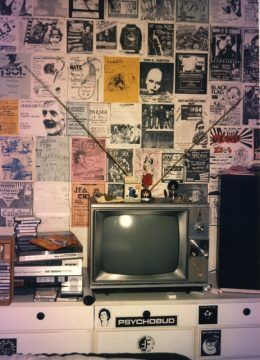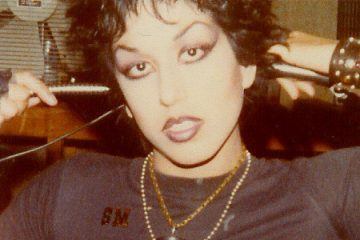by Mindy Clegg

In issue 85 of The Big Takeover, regular contributor Tim Sommer declared in his editorial that we continue to get punk wrong. Rather than a singular historical event, split between NYC and London, he argued for two different events with a shared name happening in each place.1 He advocates for something like a polygenist theory of punk, which he argues only stabilized in definition in the early 1990s with the popularity of Green Day and the like. There is much to like about his argument, most notably the acknowledgment that people often attempt to shoehorn a neat and tidy narrative onto the past in a way that does little justice to history. Without meaning to perhaps, he mostly points out the divergence between histories written by music critics (often, but not always, in service to the mainstream of the recording industry) and those written by historians seeking to better understand change over time.
The corporate-driven narratives some more mainstream critics produce represents the kind of bad history he’s rebelling against here, histories that assume and anticipate outcomes and progress. In these sorts of historical accounts, the end is already established and all roads lead to the Rock & Roll Hall of Fame. Sommer hovers around that, while not precisely coming out and saying it. After all, he very well knows the problems with the mainstream music industry dominating the narrative. I wish to springboard off Sommer’s insights to highlight a more nuanced view of the history of punk rock, one of the two most important musical movements in the last quarter of the twentieth century (the other being hip hop).
First, I want to bridge the divide between critics and professional historians a bit. I argue that the work they do are complementary rather than at odds. I also seek to illustrate that although the histories in New York and London are specific, they still both fit within a larger narrative that gives us the larger social identity of punk rock. This manifests not with the larger co-option and acceptance by the mainstream industry in the 1990s, but rather in the explosion of underground music in the 1980s which created translocal communities that shared an identity of punk. Even today, the ethos developed around punk with regards to the production of popular music (and other forms of art, frankly) influence subcultures around the world, even those not specifically countercultural in nature. Punk’s influence then is far more than just the shaping of genre—it’s the crafting of shared subcultural identities and an ethos of independence for various kinds of cultural production.
In the past two decades, punk has started to become more relevant in academic study, in part because more academics spent their formative years in punk or other aligned underground scenes. There is even a punk and postpunk academic journal.2 The goals of academic historians of punk and of music critics writing on punk in some ways intersect, but diverge in others. Academic historians, even those with a background or connections in a counterculture are primarily driven by answering a “so what?” type question. First and foremost, we attempt to pull out a larger meaning out of punk as a social and cultural phenomenon—from what specific circumstances did punk as a social identity arise, why did it spread as it did, how did it shape the production of popular music. Academic studies of punk go back to around the time these early scenes gained public notoriety, with Dick Heddige’s 1979 study Subculture: The Meaning of Style. A student of Centre for Contemporary Cultural Studies at the University of Birmingham in the UK, he sought to contextualize the rise of working class subcultures, such as teddy boys, mods, rockers, skinheads, and punks against the changing landscape of the postwar period. It was one of the first foundational texts for anyone interested in the rise and spread of youth subcultures as oppositional culture.3 A more recent example is Dewar MacLeod’s Kids of the Black Hole where he links the rise of the LA punk scene with suburban alienation, youth unemployment, and a backlash against the rise of conservatism in Orange County especially.4 Others have tackled punk as a larger narrative in the history of a particular place, such as in Jonathyne Briggs’ history of French popular music in the age of globalization, Sounds French.5 These and other academics developed particular questions related to punk that spilled out into a larger set of issues which may interest scholars who might not care about punk music for its own sake. These works help us to see punk as more than just a niche subculture with no historical import. They highlight that subcultures have meaning whether or not our music collection includes selections from music labels like Fat Wreck Chords or Dischord Records. By understanding a phenomenon like punk, we better understand the complicated processes in which it arose. These scholars are making arguments about the phenomenon of punk. It’s more than just establishing names, dates, times, circumstances after all—the goal here is to make meaning about of them.

When writing music histories, critics tend towards work that reinforces industry narratives that atomize their subjects from larger historical forces. This is not to say that critics who write histories of punk can’t also embed their work into the larger flows of history. Two particular works on the history of punk by well-known critics are must reads for those of us who study punk inside the academy. First is American rock critic Greil Marcus’ excellent Lipstick Traces. Marcus contextualizes punk in a greater narrative of engagement with underground culture over the course of the twentieth century, making strong connections to larger historical forces.6 Jon Savage, a British music journalist, has similarly written thoughtful and expansive works on punk and postpunk musics. Few rock biographies bring their subjects to light as his history of the Sex Pistols, England’s Dreaming.7 These works, though written for a general audience, do precisely what an academic might—make an argument and embed specific details in a larger historical framework. Both provide valuable service for those interested in punks recollections of how their scenes evolved. Oral histories have also become an increasingly popular format for telling the punk story. Legs McNeil and Gillian McCain put together a well-regarded oral history of the New York punk scene Please Kill Me, which allowed the members of the NYC scene to speak for themselves, which highlight the conflicting, overlapping narratives that make up any particular kind of scene. However, the only real analysis offered up consists of the implicit ones in how they decided to insert selections from their interviews together, and who they deemed worthy of inclusion in that narrative.8 Brendan Mullen and Marc Spitz did similar work for the LA scene, with We Got the Neutron Bomb.9 Such oral histories provide a critical resource for those wishing to study the history of punk (or other music based subcultures). Like autobiographies, they provided insight into how a scene was experienced by those who were part of it. As long as the usual caveats are taken into account, these are incredibly useful tools for writing a punk history. Some histories offer up meaningful relics that chart an ongoing social world, rather than claim to give the whole narrative at once, such as Bryan Ray Turcotte’s Punk is Dead, Punk is Everything, where he reprints flyers, art, set lists, zines, and other punk ephemera.10 George Gimarc’s exhaustive Punk Diary likewise collects names and dates of specific events, such as shows, recording sessions, and even social contacts.11 These can be invaluable for pinning down times and events, and for pointing historians towards a useful archive that can tell the punk story.
Other histories prove less helpful. These narratives promote the concept of underground to mainstream “selling out”—a dubious narrative when it comes to punk I’ve found in my own research. The magazine Mojo put out Punk: The Whole Story, which essentially charts a straight line from the Sex Pistols to Green Day, which I find a questionable narrative approach.12 Such works promote a teleological history of punk and reinforce the underground to mainstream co-option theory. Much the same can be said of Clinton Heylin’s Babylon’s Burning, which seeks to focus on these early scenes that were much more a marginal part of the mainstream industry at the expense of the later scene that developed around hardcore punk. Heylin’s work merely reinforces the notion that the industry co-opted the energy of punk and killed it, rather than punks having embraced underground translocal scenes that thrive to this day.13 Truth be told, I’ve wracked my brain thinking of just what Sommer was complaining about—wrongheaded punk histories, which I’m sure exist. There just aren’t that many really terrible ones that get it all wrong in my experience, just ones that are more expansive and historically minded than others. Most punk histories I’ve read are written by those with some actual experience of punk rock or other subcultures. As such, they are more invested in getting it “right.” But it also means that often the subjective experience takes precedence over the subjectivity of others, or the more divorced take of an outsider, which leads to Sommer’s criticism of us always getting punk wrong. He’s correct because like most historical phenomena, nothing about the development of punk was straightforward. He’s right that we should attend to the specific histories of punk instead of a “history” of punk. Events in New York and London were very different, even if we can chart some similar circumstances. But the meaning of “punk” are contested among those who embrace it. For some, punk is long dead, a genre that provides a useful carcass for the mainstream recording industry. The narrative of underground subculture co-opted by the recording industry works perfectly well for their purposes. It feeds an easy to understand, teleological narrative that helps them better understand the world. For others, punk represents a particular identity related to the production of culture and rejection of mainstream norms on a variety of fronts.

So, is Sommer correct that we can’t come to some larger narrative about punk itself? I’d argue that we can, even if that means crafting multiple, overlapping narratives. I have found the concepts of consumer-based identity formation and translocal communities helpful in thinking about punk historically. Punk evolved in an era of intense globalization with competition to define that concept. Most certainly the Soviets and the Americans had very different ideas about the best path forward in making an interconnected world during the Cold War, with the decolonizing world also seeking to define globalization for themselves. But I argue that people within all three “worlds” sought to define this phenomenon for themselves, while seeking to rebuild a sense of community in an era of mass society (both communist and capitalist). Consumerism provided one path for crafting a shared identity. The intensification of globalization in this period allowed people to interact across national boundaries more directly, something which both the Soviets and Americans unintentionally facilitated at various points during the Cold War with cultural exchanges. Greater interconnection meant greater shared experiences at a distance, which we can see in a phenomenon like punk. One specific example of a shared geo-political reality shaping punk is the OPEC Oil Embargo after the Yom Kippur War in 1973. While this had a much bigger impact directly on the American economy than the British one, it was a shock to the global economy.14 Global economic issues most certainly exacerbated problems in New York and London, even if they manifested in different ways. The urban decay of NYC during this period gave a measure of freedom and independence to some even if it meant a greater degree of danger, with both punks and early hip hop artists and fans carving out cultural niches. By 1975, NYC was attempting to declare bankruptcy.15 London saw similar problems, shaped in part by the changing demographics of post-colonial Britain, the ongoing Troubles in North Ireland that spilled over into the rest of the UK, serious labor unrest, and a slowing economy which shaped the Thatcher years.16
The similarities and differences shaped both scenes, but they still shared a common identity, built up and refined over this period. By the time that the long-running punk zine Maximum Rock-n-Roll was founded in 1982, the first wave scenes were done and a new group of young people had embraced the identity of punk for their own purpose.17 Here is where I mostly diverge from Sommer’s analysis that puts a firm definition with the early 90s wave of grunge. I argue that by the early 80s, a shared sense of a distinct punk identity had emerged that associated itself with independent music production, an emphasis on local scenes, a relatively well-defined sound and image (hardcore punk), and a world-wide archipelago of scenes that regularly communicated to each other via the internet of their day—fanzines such as MRR. Punk went translocal, where the action is all local, but the identity is shared across various boundaries. Reading over issues of zines like MRR, one finds constant discussion and debate about punkness, often very heated with little resolution. But a shared sense of identity rises out of the uproar found in the pages of these zines. Other genres emerged out of the original punk scenes that also followed a similar path of translocal scene building (goth, industrial, new romantic, new wave, etc). Artists and fans within these postpunk subgenres forged shared identities and created institutions to support the members of their scenes, setting off a wave of cultural entrepreneurship that helps maintain those identities to this day.

My working definition of punk, then, is a cultural phenomenon that moved from the margins of the mainstream music industry to become a translocal set of communities with a shared sense of identity, history and cultural interests. Pulling from the early youth rebellion of the 1960s (that they both emulated and rebelled against), scenes that became known as first wave punk embraced the terminology but made a variety of kinds of music in a variety of social circumstances in major cities. As these scenes grew in status and notoriety, the mainstream industry rejected these artists who still defined themselves as punk, leaving them with little choice but to forge their own economic paths. In the process, they influenced how people came to see cultural production in a variety of cultural fields—independent production and artist control became increasingly central to the discussion around culture, especially popular music. Today, even very mainstream artists like Taylor Swift regularly discuss the business of making music and how artists should be in control of their work.18 In addition to creating an alternative to the corporate industry of music production, punk and postpunk scenes also helped bring out into the open how our musical sausage is made. These scenes also represent a new sense of identity formation precipitated in part by the Cold War itself, that of embracing an identity shaped by one’s cultural consumption. In other words, punk itself might be a part of a larger historical phenomenon of people re-orienting themselves in the real and perceived failures of the Cold War period. In that way, punk seems both more coherent and pioneering, as today we live in a world where cultural identities based on patterns of consumption seem more powerful and ubiquitous than ever before. If indeed our identities are more than ever tied to consumerism, that seems to me a historical process worth exploring.
I also would like to wish everyone the Happiest of Holiday seasons. I will leave you with some Punk Holiday classics…. probably not safe for work!
Footnotes
1 The quarterly music magazine The Big Takeover began life as a zine in NYC and continues to be an excellent source of information on a variety of music. Sommer publishes a regular editorial there in each issue.
2 Punk and Postpunk has been publishing since 2012.
3 Dick Heddige, Subcultures: The Meaning of Style, London: Routledge, 1979
4 Dewar MacLeod, Kids of the Black Hole: Punk Rock in Postsuburban California, Norman: University of Oklahoma Press, 2010
5 Jonathyne Briggs, Sounds French: Globalization, Cultural Communities, & Pop Music, 1958-1980, New York: Oxford University Press, 2015
6 Greil Marcus, Lipstick Traces: A Secret History of the Twentieth Century, Cambridge: Harvard University Press, 1989 – he worked similar magic with rock in Mystery Train: Images of American in Rock and Roll Music, New York: Plume, 2015 (new edition)
7 Jon Savage, England’s Dreaming: Anarchy, Sex Pistols, Punk Rock, and Beyond, London: St. Martin’s Griffin, 2002
8 Legs McNeil and Gillian McCain, Please Kill Me: The Uncensored Oral History of Punk, New York: Grove Press, 2006
9 Marc Spitz and Brendan Mullen, We Got the Neutron Bomb: The Untold Story of LA Punk, New York: Three Rivers Press, 2001
10 Bryan Ray Turcotte, Punk is Dead, Punk is Everything: Raw Material from the Martyred Music Movement, Corte Madera, CA: Ginko Press, 2007
11 George Gimarc, Punk Diary: The Ultimate Trainspotter’s Guide to Underground Rock, 1970-1982, San Francisco: Backbeat Book, 2005
12 Punk: The Whole Story, London: DK, 2006
13 Clinton Heylin, Babylon’s Burning: From Punk to Grunge, New York: Canongate, 2007
14 For the oil shocks, see “Oil Embargo, 1973-1974,” Office of the Historian, US Department of State, State Dept. and Terry Macalister, “Background: What Caused the 1970s Oil Price Shock?,” The Guardian, March 3, 2011, The Guardian
15 For some background on the financial crisis in NYC in the 1970s, see Sam Roberts, “When New York Teetered on the Brink of Bankruptcy,” City Rooms: New York Times, July 25, 2013, New York Times Cityroom blog, “The Legacy of the 1970s Fiscal Crisis,” The Nation, April 16, 2013, The Nation, and for the impact it had on creative types, check out the excellent and thoughtful, Sarah Schulman, The Gentrification of the Mind: Witness to a Lost Imagination, Berkeley: University of California Press, 2012.
16 See “1976: Notting Hill Carnival Ends in Riot,” On This Day 1950-2005: BBC, BBC On This Day “1972 and 1974 Miners’ Strike,” Coalfield Web Materials, 2002, Coalfield Web Materials and “The Thatcher Years in Statistics,” BBC, April 9, 2013, BBC.
17 “Maximum Rocknroll: About,” Maximum Rocknroll, About MRR.
18 See the recent discussion on Taylor Swift’s back catalog, which highlights how discussion on ownership rights have moved into the mainstream industry, Sam Sadomsky, “Taylor Swift’s Music Ownership Controversy with Scooter Braun: What It Means and Why It Matters,” Pitchfork, July 1, 2019, Pitchfork Magazine.
